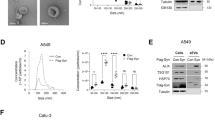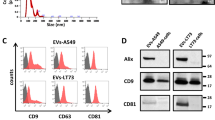Abstract
Extracellular vesicles (EVs) have received increasing attention for their role as possible regulators of cancer. miR-221-3p is a microRNA (miR) up-regulated in EVs secreted by drug-resistant A549-GR lung cancer cells. However, the underlying mechanism through which miR-221-3p-containing EVs regulate the progression of lung cancer remains elusive. Here, we attempted to reveal the mechanism by which miR-221-3p-containing EVs secreted by drug-resistant lung cancer cells regulate the functions of surrounding cells during the progression of lung cancer. A gemcitabine-sensitive lung cancer cell line was treated with isolated drug-resistant lung cancer EVs followed by an evaluation of the proliferation and migration of sensitive lung cancer cell lines and their resistance to gemcitabine treatment. Moreover, the miR-221-3p target gene HMBOX1 was identified by the Targetscan database while the progression of lung cancer was detected by knocking down miR-221-3p or overexpressing HMBOX1, or by treating sensitive cell lines with Akt/mTOR activator and inhibitor, respectively. Furthermore, an in vivo study was performed to validate the relationship between miR-221-3p and HMBOX1 and their roles in the progression of lung cancer. The proliferation and migration of sensitive lung cancer cell lines and their resistance to drugs were significantly enhanced after the treatment with drug-resistant EVs. Knockdown of miR-221-3p (in the EV of drug-resistant lung cancer or overexpression of HMBOX1 in sensitive lung cancer cell lines) reduced the transformation of sensitive lung cell lines, whereas, the treatment of sensitive lung cell lines with Akt/mTOR activator or inhibitor significantly affected the progression of lung cancer. In vivo experiments further confirmed that miR-221-3p released by drug-resistant lung cancer cells targeted the HMBOX1 to regulate the Akt/mTOR signaling pathway and affected the progression of lung cancer. We conclude that miR-221-3p-containing EVs secreted by drug-resistant lung cancer cells can potentially activate the Akt/mTOR signaling pathway by inhibiting HMBOX1, promoting the progression of lung cancer. The regulation of miR-221-3p represents a novel therapeutic target for the treatment of lung cancer.
This is a preview of subscription content, access via your institution
Access options
Subscribe to this journal
Receive 12 print issues and online access
$259.00 per year
only $21.58 per issue
Buy this article
- Purchase on Springer Link
- Instant access to full article PDF
Prices may be subject to local taxes which are calculated during checkout







Similar content being viewed by others
Change history
20 July 2021
A Correction to this paper has been published: https://doi.org/10.1038/s41417-021-00364-y
References
Garon EB, Rizvi NA, Hui R, Leighl N, Balmanoukian AS, Eder JP, et al. Pembrolizumab for the treatment of non-small-cell lung cancer. N Engl J Med. 2015;372:2018–28.
Sun G, Liu B, He J, Zhao X, Li B. Expression of EGFR is closely related to reduced 3-year survival rate in Chinese female NSCLC. Med Sci Monit. 2015;21:2225–31.
Toschi L, Finocchiaro G, Bartolini S, Gioia V, Cappuzzo F. Role of gemcitabine in cancer therapy. Future Oncol. 2005;1:7–17.
Tokunaga Y, Liu D, Nakano J, Zhang X, Nii K, Go T, et al. Potent effect of adenoviral vector expressing short hairpin RNA targeting ribonucleotide reductase large subunit M1 on cell viability and chemotherapeutic sensitivity to gemcitabine in non-small cell lung cancer cells. Eur J Cancer. 2015;51:2480–9.
Raposo G, Stoorvogel W. Extracellular vesicles: exosomes, microvesicles, and friends. J Cell Biol. 2013;200:373–83.
Qu JL, Qu XJ, Zhao MF, Teng YE, Zhang Y, Hou KZ, et al. Gastric cancer exosomes promote tumour cell proliferation through PI3K/Akt and MAPK/ERK activation. Dig Liver Dis. 2009;41:875–80.
Hood JL, San RS, Wickline SA. Exosomes released by melanoma cells prepare sentinel lymph nodes for tumor metastasis. Cancer Res. 2011;71:3792–801.
Wu ZH, Tao ZH, Zhang J, Li T, Ni C, Xie J, et al. MiRNA-21 induces epithelial to mesenchymal transition and gemcitabine resistance via the PTEN/AKT pathway in breast cancer. Tumour Biol. 2016;37:7245–54.
Liu Y, Li Y, Wang R, Qin S, Liu J, Su F, et al. MiR-130a-3p regulates cell migration and invasion via inhibition of Smad4 in gemcitabine resistant hepatoma cells. J Exp Clin Cancer Res. 2016;35:19.
Fan P, Liu L, Yin Y, Zhao Z, Zhang Y, Amponsah PS, et al. MicroRNA-101-3p reverses gemcitabine resistance by inhibition of ribonucleotide reductase M1 in pancreatic cancer. Cancer Lett. 2016;373:130–7.
Krebs M, Solimando AG, Kalogirou C, Marquardt A, Frank T, Sokolakis I. et al. miR-221-3p regulates VEGFR2 expression in high-risk prostate cancer and represents an escape mechanism from sunitinib in vitro. J Clin Med. 2020;9:670.
Li H, Zhang B, Ding M, Lu S, Zhou H, Sun D, et al. C1QTNF1-AS1 regulates the occurrence and development of hepatocellular carcinoma by regulating miR-221-3p/SOCS3. Hepatol Int. 2019;13:277–92.
Zhou S, Xiao Y, Zhuang Y, Liu Y, Zhao H, Yang H, et al. Knockdown of homeobox containing 1 increases the radiosensitivity of cervical cancer cells through telomere shortening. Oncol Rep. 2017;38:515–21.
Zhao H, Jia H, Han Q, Zhang J. Homeobox containing 1 inhibits liver cancer progression by promoting autophagy as well as inhibiting stemness and immune escape. Oncol Rep. 2018;40:1657–65.
Jiao D, Wang J, Lu W, Tang X, Chen J, Mou H, et al. Curcumin inhibited HGF-induced EMT and angiogenesis through regulating c-Met dependent PI3K/Akt/mTOR signaling pathways in lung cancer. Mol Ther Oncolytics. 2016;3:16018.
Zhang Q, Qiao H, Wu D, Lu H, Liu L, Sang X, et al. Curcumin potentiates the galbanic acid-induced anti-tumor effect in non-small cell lung cancer cells through inhibiting Akt/mTOR signaling pathway. Life Sci. 2019;239:117044.
de Sousa Cavalcante L, Monteiro G. Gemcitabine: metabolism and molecular mechanisms of action, sensitivity and chemoresistance in pancreatic cancer. Eur J Pharm. 2014;741:8–16.
Yin Z, Xu M, Li P. miRNA-221 acts as an oncogenic role by directly targeting TIMP2 in non-small-cell lung carcinoma. Gene 2017;620:46–53.
Garofalo M, Di Leva G, Romano G, Nuovo G, Suh SS, Ngankeu A, et al. miR-221&222 regulate TRAIL resistance and enhance tumorigenicity through PTEN and TIMP3 downregulation. Cancer Cell. 2009;16:498–509.
Yamashita R, Sato M, Kakumu T, Hase T, Yogo N, Maruyama E, et al. Growth inhibitory effects of miR-221 and miR-222 in non-small cell lung cancer cells. Cancer Med. 2015;4:551–64.
Wei F, Ma C, Zhou T, Dong X, Luo Q, Geng L, et al. Exosomes derived from gemcitabine-resistant cells transfer malignant phenotypic traits via delivery of miRNA-222-3p. Mol Cancer. 2017;16:132.
Liu X, Xiao J, Zhu H, Wei X, Platt C, Damilano F, et al. miR-222 is necessary for exercise-induced cardiac growth and protects against pathological cardiac remodeling. Cell Metab. 2015;21:584–95.
Yu YL, Diao NN, Li YZ, Meng XH, Jiao WL, Feng JB, et al. Low expression level of HMBOX1 in high-grade serous ovarian cancer accelerates cell proliferation by inhibiting cell apoptosis. Biochem Biophys Res Commun. 2018;501:380–6.
Diao N, Li Y, Yang J, Jin C, Meng X, Jiao W, et al. High expression of HMBOX1 contributes to poor prognosis of gastric cancer by promoting cell proliferation and migration. Biomed Pharmacother. 2019;115:108867.
Hu H, Wang F, Wang M, Liu Y, Wu H, Chen X, et al. FAM83A is amplified and promotes tumorigenicity in non-small cell lung cancer via ERK and PI3K/Akt/mTOR pathways. Int J Med Sci. 2020;17:807–14.
Xu J, Xiao Y, Liu B, Pan S, Liu Q, Shan Y, et al. Exosomal MALAT1 sponges miR-26a/26b to promote the invasion and metastasis of colorectal cancer via FUT4 enhanced fucosylation and PI3K/Akt pathway. J Exp Clin Cancer Res. 2020;39:54.
Krebs M, Behrmann C, Kalogirou C, Sokolakis I, Kneitz S, Kruithof-de Julio M, et al. miR-221 augments TRAIL-mediated apoptosis in prostate cancer cells by inducing endogenous TRAIL expression and targeting the functional repressors SOCS3 and PIK3R1. Biomed Res Int. 2019;2019:6392748.
Liao W, Zhang Y. MicroRNA-381 facilitates autophagy and apoptosis in prostate cancer cells via inhibiting the RELN-mediated PI3K/AKT/mTOR signaling pathway. Life Sci. 2020;254:117672.
Yang J, Cong X, Ren M, Sun H, Liu T, Chen G, et al. Circular RNA hsa_circRNA_0007334 is predicted to promote MMP7 and COL1A1 expression by functioning as a miRNA sponge in pancreatic ductal adenocarcinoma. J Oncol. 2019;2019:7630894.
Li L, Li C, Wang S, Wang Z, Jiang J, Wang W, et al. Exosomes derived from hypoxic oral squamous cell carcinoma cells deliver miR-21 to normoxic cells to elicit a prometastatic phenotype. Cancer Res. 2016;76:1770–80.
Kim DH, Park S, Kim H, Choi YJ, Kim SY, Sung KJ, et al. Tumor-derived exosomal miR-619-5p promotes tumor angiogenesis and metastasis through the inhibition of RCAN1.4. Cancer Lett. 2020;475:2–13.
Parimon T, Brauer R, Schlesinger SY, Xie T, Jiang D, Ge L, et al. Syndecan-1 controls lung tumorigenesis by regulating miRNAs packaged in exosomes. Am J Pathol. 2018;188:1094–103.
Acknowledgements
We would like to express our sincere appreciation to the reviewers for critical comments on this article.
Author information
Authors and Affiliations
Contributions
JL and YZ designed the study. JL and YZ collated the data, carried out data analyses, and produced the initial draft of the manuscript. YZ and JW contributed to drafting the manuscript. All authors have read and approved the final submitted manuscript.
Corresponding author
Ethics declarations
Conflict of interest
The authors declare that they have no conflict of interest.
Additional information
Publisher’s note Springer Nature remains neutral with regard to jurisdictional claims in published maps and institutional affiliations.
This article has been retracted. Please see the retraction notice for more detail: https://doi.org/10.1038/s41417-021-00364-y
About this article
Cite this article
Li, J., Zhao, Y. & Wang, J. RETRACTED ARTICLE: Extracellular vesicle-associated microRNA-221-3p secreted by drug-resistant lung cancer cells targets HMBOX1 to promote the progression of lung cancer. Cancer Gene Ther 28, 679–692 (2021). https://doi.org/10.1038/s41417-020-00249-6
Received:
Revised:
Accepted:
Published:
Issue Date:
DOI: https://doi.org/10.1038/s41417-020-00249-6



